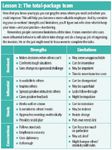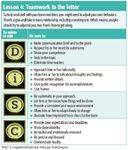Different strokes for different communication styles
When a bunch of different folks form a team, conflict arises. Stop hunting and pecking for a solution. Here's the key to working together: Identify what pushes your co-workers' buttons.
Some people are hard to work with. You know who I'm talking about—the person who doesn't even utter a friendly hello at the start of the day.

Hold on, not so fast. Before you point fingers, consider this: Some team members are so task-driven that they really do forget the social niceties many of us appreciate. Look at work from their perspective. Stopping to say, "Good morning," seems unnecessary and superficial when there's so much to be done.
Working with people who exhibit different behavior types can certainly drive you crazy, but these differences make your team stronger. Can you imagine a practice full of people who work just like you? This idea may sound fabulous at first. For example, if your team was made up only of people-pleasers, everyone would sacrifice their needs for the group. Every employee would stay late and come in early. The phones would always be answered in a kind manner. Where's the stapler? Right here, next to the pens and sticky notes, perfectly organized as usual.
On the flip side, no one would ever feel an urgent need to take on new challenges. Your team wouldn't focus on accuracy. In the end, a team of you, no matter how great you are, would cause problems for employees and clients—and you.
So put personal preferences aside and start putting your team's differences to good use. This will take practice. It's hard not to judge co-workers based on your own background, motivations, and values. But try to step back, get to know your team members, and gain a better understanding of why they do what they do. Get started by checking out the information in the following charts.
Follow these four lessons and find the hidden harmony among your practice's personalities.
Lesson 1: Typecasting can be a good thing
Click on Table 1 to see which characteristics best describe you—and your team members—when you're on the job.

Table 1
Lesson 2: The total package team
Now that you know your type, click on Table 2 to peg the areas where you excel and where you could improve.

Table 2
Lesson 3: Put employees in their places
Click on Table 3 to view what tasks best suit your behavior type.

20085
Lesson 4: Teamwork to the letter
Click on Table 4 to learn how you can relate to every personality. (Check out the bonus table on the next page.)

Table 4

For fun: Mornings at the clinic
Next time conflict strikes your practice team, take a minute to consider why people are acting the way they are. Maybe a person whose behaviors lean toward dominance is struggling with a steady person's style of handling situations methodically. When you identify the behaviors people are exhibiting, you'll know how to most effectively communicate to de-escalate the situation. Even better, you'll learn how to prevent the same problems in the future. And that's a stroke of true team-work genius.

Debbie Allaben Gair, CVPM
Get your customized DISC profile and personalized advice from Debbie Allaben Gair, CVPM, on improving practice communications by attending Firstline Live at CVC Kansas City. For more information and to register, click here.